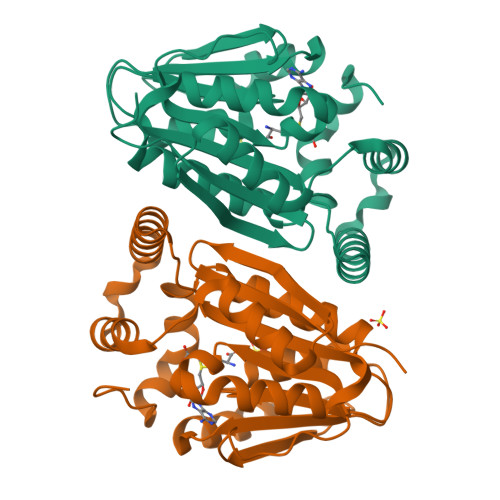Structure-guided discovery of the metabolite carboxy-SAM that modulates tRNA function
Kim, J., Xiao, H., Bonanno, J.B., Kalyanaraman, C., Brown, S., Tang, X., Al-Obaidi, N.F., Patskovsky, Y., Babbitt, P.C., Jacobson, M.P., Lee, Y.-S., Almo, S.C.(2013) Nature 498: 123-126
- PubMed: 23676670
- DOI: https://doi.org/10.1038/nature12180
- Primary Citation of Related Structures:
4GEK - PubMed Abstract:
The identification of novel metabolites and the characterization of their biological functions are major challenges in biology. X-ray crystallography can reveal unanticipated ligands that persist through purification and crystallization. These adventitious protein-ligand complexes provide insights into new activities, pathways and regulatory mechanisms. We describe a new metabolite, carboxy-S-adenosyl-l-methionine (Cx-SAM), its biosynthetic pathway and its role in transfer RNA modification. The structure of CmoA, a member of the SAM-dependent methyltransferase superfamily, revealed a ligand consistent with Cx-SAM in the catalytic site. Mechanistic analyses showed an unprecedented role for prephenate as the carboxyl donor and the involvement of a unique ylide intermediate as the carboxyl acceptor in the CmoA-mediated conversion of SAM to Cx-SAM. A second member of the SAM-dependent methyltransferase superfamily, CmoB, recognizes Cx-SAM and acts as a carboxymethyltransferase to convert 5-hydroxyuridine into 5-oxyacetyl uridine at the wobble position of multiple tRNAs in Gram-negative bacteria, resulting in expanded codon-recognition properties. CmoA and CmoB represent the first documented synthase and transferase for Cx-SAM. These findings reveal new functional diversity in the SAM-dependent methyltransferase superfamily and expand the metabolic and biological contributions of SAM-based biochemistry. These discoveries highlight the value of structural genomics approaches in identifying ligands within the context of their physiologically relevant macromolecular binding partners, and in revealing their functions.
Organizational Affiliation:
Department of Biochemistry, Albert Einstein College of Medicine, Bronx, New York 10461, USA. jungwook.kim@einstein.yu.edu




















